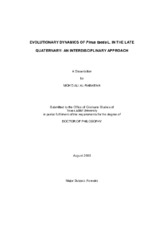Evolutionary dynamics of Pinus taeda L. in the Late Quaternary: An interdisciplinary approach
Abstract
Pinus taeda L. dynamics, migration patterns and genetic structure were investigated over geological time scale (the past 21,000 years), historical time scale (the past 500 years) and recent time scale (the past 50 years ago) using multi-source data and an interdisciplinary approach. Population genetics, microsatellite markers, DNA fingerprinting, fossil records, geological history, historical records, aerial photographs, soil maps, weather data, remote sensing and geographic information systems (GIS) were used to assess the dynamics of P. taeda populations especially for the Lost Pines (LP), a disjunct population at the westernmost edge of the species range.
Pinus taeda populations east and west of the Mississippi River Valley are genetically differentiated. Eastern populations had higher allelic diversity and diagnostic alleles than western populations. Gene flow estimates are high. Allelic diversity and diagnostic alleles patterns are attributed to the prevailing wind direction. Differentiation east and west of the MRV was attributed to separation to two refugia during the Pleistocene.
The Lost Pines population is believed to have undergone one or more bottleneck events with loss of rare alleles. Despite the bottleneck, allelic richness was similar for the LP and the control population from the Western Gulf (WG) population. Population size contraction of the LP was attributed to climate change in central Texas over geological time scale.
The natural origin of the Lost Pines was investigated. Multivariate and clustering techniques and assignment and exclusion methods using DNA markers show that the LP population shared ancestry with the WG populations with no evidence for admixture from other sources. Historical records parallel this conclusion.
With the absence of logging within Bastrop and Buescher State Parks, P. taeda area and patch size increased from 1949 to 1995. Thirty six percent of the pine patches observed in 1949 had disappeared by 1995 by merging. Landscape pattern analysis shows significant dynamics. The distribution of P. taeda in Bastrop County was associated with sandy light topsoils, clayey heavy sub-soils and high permeable soils. Pinus taeda grow on various soil types as well. Growing on these soils under current climatic conditions may compensate for the precipitation regime in this area.
Citation
Al-Rabab'ah, Moh'd Ali (2003). Evolutionary dynamics of Pinus taeda L. in the Late Quaternary: An interdisciplinary approach. Doctoral dissertation, Texas A&M University. Texas A&M University. Available electronically from https : / /hdl .handle .net /1969 .1 /1208.


